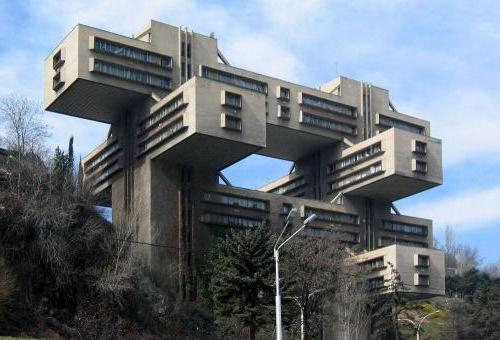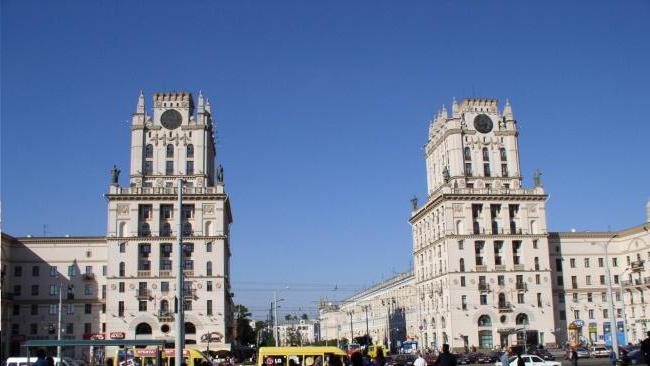The construction of a new society could not but affect the culture of the country as a whole and architecture in particular. Soviet architecture went through several stages of development, it knew the ups and downs, but in any case, it became a definite event in world architecture. In the USSR there were several architects of the highest level and today in the expanses of the post-Soviet space you can see several masterpieces of world scale. Let's talk about how the styles of Soviet architecture evolved, and how it developed.
Features and objectives of Soviet architecture
After the October Revolution of 1917, the new government of the country actively began to change all spheres of life. For some time, everyone was not up to architecture, but it soon became clear that it, too, should fulfill an ideological function, like all other art. In the 1920s, architects were not directly tasked with creating a new space, but the creators themselves acutely felt that the time had come for new forms and began to search for expressions of ideas for change. But later, Soviet architecture was called upon to serve the ideas of socialism. All art in the USSR was to prove the only right way of development — socialist. This determined the main features of Soviet architecture, which should always have been primarily ideological, and lastly beautiful. If at first the creators still managed to combine benefit, idea and beauty, then gradually aesthetics gave way to utilitarianism, and this led to a decline in the potential of great architecture.
Historical essay
The development of Soviet architecture went through several stages. The origin of this phenomenon is associated with the period of 20 - the beginning of the 30s, when there is an active search for new forms, the classical methods of architecture are rethought. At this time, two main avant-garde trends of Soviet architecture took shape: constructivism and rationalism. At the end of the 30s, it became clear that the vanguard was not on the way with the ideological Soviet culture. A new architecture is beginning to take shape, the purpose of which is to glorify the greatness and achievements of the socialist idea. The implementation of the ideas of this period was prevented by the Second World War, after which a new period in architecture begins. It is associated not only with the restoration of destroyed cities, but also with the creation of a new space that would maintain a person's sense of pride in his country. It is on this ideological basis that the Stalinist empire is formed , with its thirst for scale. The beginning of the 60s exacerbated the problem of residential architecture. People lived in inhuman conditions, and this could no longer be attributed to post-war reconstruction. It is necessary to solve the problem of building mass housing. This problem was solved by maximizing the cost of projects. This turned into a tragedy for Soviet architecture. which chose not the best way of development and followed the French in their functional type construction.
All creative attempts of architects were recognized as excessive and harmful. What made the creators engage in "paper architecture", that is, create projects without hope of implementation. In the 80s, Soviet architects were keenly aware of the impending crisis. At this time, a typical, faceless project dominated. Architecture is transformed from art to simple drawing skill. It began to emerge from this crisis very slowly only by the end of the 90s, but this is already the post-Soviet period.
Soviet avant-garde
At the end of the Civil War, the question arose about the restoration of Moscow. By this time, two new directions had taken shape in the country's architecture: constructivism and rationalism. They were created by prominent architects who were formed within the framework of the Russian and European traditions, but saw the need to create a new architecture that would meet new realities. At that time, the creators were fascinated by the idea of creating a new society and forming a new, harmonious person.
Constructivists led by the Vesnin brothers, Konstantin Melnikov, Moses Ginzburg believed that the composition of the building should correspond to the function. They refused historical continuity, giving the main role to simple designs with a minimum of decor. Thanks to them, the architecture of the Soviet avant-garde was enriched by such structures as the round house of K. Melnikov in Moscow, the building of the Izvestia newspaper, the ZIL Palace of Culture and many others. The direction was very favorably received by architects and its branches appeared in Leningrad, Kharkov, Gorky, Sverdlovsk. In many cities of the former USSR, today you can admire the constructivist buildings.

The second avant-garde trend, rationalism, led by N. Ladovsky and V. Krinsky, received less realization than constructivism. They saw the main thing in their work as accounting for the psychology of building perception by a person. In the early 30s, the avant-garde was recognized as ideologically alien to Soviet art and quickly ceased to exist. Rationalism was later “rehabilitated” and its ideas were actively used in architecture in the 60s.
Architecture of the 30-40s
In the mid-1930s, Soviet architecture entered a new period. The new government is ripening the need for mass reconstruction of residential and public buildings, construction of structures of a new type, for example, a platform for an agricultural exhibition. Traditional techniques and methods come to the fore. At the head of the traditionalists stands the excellent architect of the old school, neoclassicist I. Zholtovsky. Retrospective in his views, he returns to domestic practice the love of columns, pilasters, arches, etc. In this period, the influence of constructivism was still strong, but the bias towards the classics became more and more clear. Before the start of World War II, a construction boom was observed in the country, especially in Moscow. The VDNH complex, the State Library named after Lenin, several Moscow metro stations are being built. In Kharkov, the ensemble of Dzerzhinsky Square is being built. Government House appears in Yerevan. New cities appear on the USSR map, the plans of which embody the ideas of new architecture. These are Komsomolsk-on-Amur, Magnitogorsk, Khabarovsk. Before the war, about 170 million square meters were built in the country. m of housing. Gradually, a new, imperial style of the USSR.

Stalin's Empire
After the Second World War, the history of Soviet architecture enters a new stage. It took a lot of resources to restore the destroyed settlements. In the mid-40s in the USSR, the second “big style” in architecture, the Stalinist Empire, developed after constructivism. He combined several directions: classicism, baroque, art deco, empire. He was characterized by scope, pomp, grandeur. Buildings in this style were designed to demonstrate the victory and scale of Soviet achievements. The Moscow “skyscrapers” became famous for this style: Moscow State University, Ukraine Hotel, the Ministry of Foreign Affairs and others. The Stalinist Empire style became the dominant style for 150 years; it changed the face of the country. Stalinist architecture appeared in almost all cities of the country.
Massive residential architecture
In the postwar period, the housing problem became acute. But in the 1950s, management could not decide it, since it was necessary to restore the production infrastructure. But in the 60s to postpone the solution to this problem was already impossible. Just by this time the end of the Stalin era came and N. Khrushchev called for cheaper housing construction. He also initiated the fight against "artistic excesses", it was recommended to take the quarters of French functionalism as a model. So the famous Cheryomushki appeared, as an example of a new residential environment. All social infrastructure facilities should have been in the quarter, and buildings should provide a minimum area for each resident.
60s-80s architecture
From the end of the 60s, mass mass construction of standard housing began. In all cities and towns of the USSR, houses from enlarged concrete parts appear. Construction is fast, people get apartments. But it’s difficult to apply the word “architecture” to this building, since the buildings were completely faceless and the same. So the architecture of the Soviet district according to a standard project in any city was like two drops of water similar to other settlements. That is exactly what the film director E. Ryazanov laughed in the film “The Irony of Fate”. Mass construction and the struggle against architectural excesses led to the fact that by the 80s the phenomenon of Soviet architecture had turned into nothing. Of course, there were some creators and buildings worthy of attention, but in general, architecture was in a deep crisis. Interestingly, living architectural work at that time moved from capitals to provinces and union republics.
Paper architecture
In the 80s, when the official architecture of the Soviet period plunged into crisis, this unusual phenomenon appeared. Young architects at that time could not rely not only on the realization of their ideas, but even on their recognition. Therefore, they created projects in paper, often sent them to various foreign competitions and won prizes. A whole generation of good architects is emerging in this area. The founders of the movement are A. Brodsky, I. Utkin, M. Belov, Yu. Avvakumov, M. Kharitonov. Architects have developed their own style of presenting ideas. Since they were sure that the projects would not be implemented, they focused on visual presentation of the concept. Basically, these architects were inspired by the ideas of antiquity, although they often created futuristic projects.
The best architects of the USSR
Soviet architecture in the first half of its history developed thanks to the work of architects who studied and formed in imperial times. After this generation is gone, there comes a short period of calm. But soon a new galaxy of architects is emerging who bring new ideas and new tasks. Specialists include K. Melnikov, V. Tatlin, A. Schusev among the best architects of the USSR. These constructivists are the real pride of our country in world architecture. Also among the best in domestic architecture are N. Ladovsky, I. Rerberg, the Vesnins, A. Krasovsky. A great contribution to the formation of the image of many Soviet cities was made by I.V. Zholtovsky, V.N. Semenov, N. Dokuchaev, B. Iofan, V. Krinsky. In Soviet times, architects were formed, who happened to transform the post-Soviet space after perestroika. Among them, it is worth mentioning I. Utkin, A. Brodsky, Yu. Grigoryan.
Interesting Facts
The architecture of the Soviet era is full of interesting objects and facts. So, the round house of K. Melnikov is one of the best monuments of constructivism in the world. Outstanding world architect Le Corbusier came to Moscow three times to be inspired by new ideas. In the 30s, the most ambitious project of Soviet architecture was created - the Palace of Soviets, whose height was to be about 400 m, 100 floors. For its implementation, the Cathedral of Christ the Savior was blown up, but the plan was not realized.